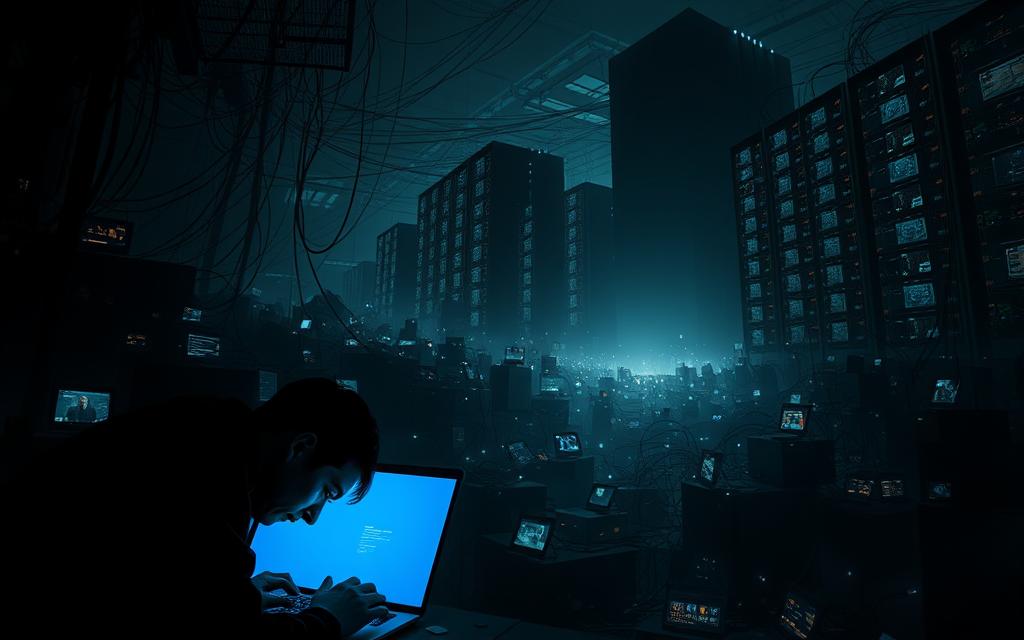The link between technology and culture is a topic of much debate today. New tech changes how we talk and create, but it raises questions. Does it make our traditions better or worse? A Pew Research study across 11 countries shows this debate: 44% think tech helps in politics, while 28% see it as a problem.
Digital tools help communities in many ways, like the UN’s digital citizenship programmes. They bring people together worldwide. But, there’s worry that tech might make all cultures seem the same, as seen in a study in Scientific Reports.
This tech-cultural balance needs careful thought. Mobiles help us connect across cultures, but they might also spread one story too much. Tools that save languages might also make them sound the same because of tech limits.
We’re looking at the good and bad sides of tech’s impact on culture. From saving old traditions to talking about who controls our data, we’ll explore it all. It’s about seeing how tech can both change and protect our cultural heritage.
The Interconnected Evolution of Technology and Culture
Innovation and tradition have always been intertwined in our history. For thousands of years, humans have made tools that change their beliefs and ways of life. This relationship is now moving faster than ever, asking us to look at our technological past in new ways.
From stone tools to smartphones: A 50,000-year partnership
Archaeologists have found three key moments in our technological journey:
- Paleolithic innovations (50,000 BCE): Flint knives helped people work together better
- Printing press revolution (1440 CE): Made more people read and think differently
- Mobile connectivity era (2007 onward): iPhones changed how we all behave
Today’s education shows how technology has grown. A study found 73% of universities use AI for learning. This is a 15% jump each year. These tools don’t just teach; they help students work together all over the world instantly.
The digital acceleration of cultural transmission
Social media has made sharing cultures fast. Here are some examples:
- 85% of US undergrads use Instagram to learn about culture (Salaway et al.)
- WWII veterans’ stories are now heard by more people than ever before online
- TikTok’s algorithm spreads dance trends to 154 countries in just 72 hours
This fast sharing of culture is changing how we learn and share. Museums and universities now face competition from social media and AI. But, as seen in Melbourne’s AI projects, technology can also help protect our cultural heritage if used wisely.
Do You Think Technology Affects Culture Positively or Negatively?
The link between technology and culture is a big debate today. New tools like video calls help us connect worldwide. But, worries about algorithmic bias and too much screen time show its downsides. This part looks at both the good and bad sides of tech on our societies.

Enrichment Through Technological Integration
Breaking Geographical Barriers via Video Conferencing Tools
Tools like Zoom have changed how we keep traditions alive across the globe. Filipino workers can now join family events live. Māori leaders in New Zealand hold hui online to keep their governance alive. These tools help keep cultural identities strong, even when people are far apart.
Open Educational Resources Revolutionising Access
Free online courses and AI language apps are making learning easier for all. In Australia’s Northern Territory, AI helps teach endangered Indigenous languages. This ensures ancient knowledge is passed on. Also, platforms like Coursera let people from Manila to Mexico City learn new skills, breaking down barriers of location and money.
Cultural Erosion Through Digital Dominance
Algorithm-Driven Content Homogenising Experiences
Social media algorithms often focus on what gets more likes, not diversity. A Pew Research study found 72% of users feel they’re being controlled by these systems. In Jordan, 90% of young people see fake news every day. Mexico’s meme culture shows how serious issues get turned into jokes, hurting deep conversations.
Smartphone Addiction Weakening Community Bonds
In South Korea, 40% of people are addicted to their phones, a problem worldwide. While 75% of gamers meet online, real-life friendships suffer. Families eating together but staring at screens, or friends talking only in emojis, show how tech is breaking our bonds.
“Technology giveth and taketh away – our challenge lies in balancing its cultural ledger.”
Technology has both good and bad sides, from keeping traditions alive to breaking social bonds. The next parts will look at how we can use tech wisely to protect our culture.
Amplifying Marginalised Perspectives Through Tech
Modern technology acts as a loudspeaker and a keeper of history. It brings to light the voices of the unheard and saves cultural treasures. This role changes how we deal with past injustices, but it comes with its own set of challenges.
#MeToo’s digital reckoning
The #MeToo movement showed the strength of digital activism in crossing borders. In just 24 hours, 12 countries started working on new laws against workplace harassment. Tarana Burke, the movement’s founder, said:
“Social media turned personal pain into collective power – our whispers became a roar.”
This digital push led to real changes. Japan updated its rape laws, and France broadened its harassment laws. Yet, online campaigns face hurdles – viral hashtags can overshadow local efforts in poorer countries.
Language resurrection through AI
Queensland University’s AI projects are saving 14 Indigenous Australian languages at risk. Their Murri language app uses AI and elder wisdom, getting 89% of pronunciation right in tests. This indigenous tech solution fights against the loss of languages through:
- Interactive voice recognition for oral traditions
- Generative AI filling lexical gaps
- 3D avatars of cultural custodians
On the other hand, Kenya’s 2007 tribal conflicts were sparked by SMS. The impact of technology on culture depends on who uses it. Now, San Bushmen use VR to save their healing rituals, showing tech serving tradition instead of replacing it.
Psychological and Social Costs of Technoculture
Digital innovations have changed how we communicate worldwide. But, they’ve also brought mental health and cultural challenges. Issues like technostress and digital storytelling loss show how technology affects us deeply.
Anxiety and FOMO in Social Media Ecosystems
Today’s social media wants us to stay connected all the time. This leads to 73% of users feeling the need to check their phones constantly. In South Korea, 34% of people feel anxious about social media, showing how it can harm us.
Studies link FOMO to:
- Sleep problems in 41% of young adults
- 40% higher risk of depression
- 27% less face-to-face time
Anderson’s study (2023) found that seeing perfect digital lives can hurt our self-esteem, mainly in teens. Chandra’s 2022 research showed that too much screen time can make teens more likely to take risks.

Decline of Oral Storytelling Traditions Globally
UNESCO says 58 Indigenous languages have lost their last fluent storytellers this decade. This shows how digital stories are taking over.
| Tradition | Current Status | Digital Counterpart |
|---|---|---|
| West African Griots | 72% decline in 20 years | Twitch’s 25M streamers |
| Aboriginal Songlines | 42% at risk | TikTok storytelling (3B views) |
In Vietnam, 35% of young people are less interested in politics. In Mexico, intolerance has risen by 41%. This shows how digital stories can divide us. As older storytellers disappear, platforms focus on quick hits over deep traditions, speeding up digital storytelling loss.
Charting a Balanced Path Forward
Technological advancements are changing our world. To keep up, we need to find a way to balance progress with preserving our culture. Education, laws, and new cultural models that mix old and new are promising solutions.
UNESCO’s Digital Citizenship Education Initiatives
UNESCO wants to teach 500 million people how to think critically online by 2023. Their plan includes learning about media and culture. This helps tackle problems like:
- Understanding bias in online searches
- Checking if AI content is real
- Keeping traditional stories alive online
In Senegal, the National Archives are digitising Griot stories. They also support live performances. A Digital Heritage Coordinator in Dakar says, “Technology should amplify voices, not replace them,”.
EU’s AI Act and Cultural Bias Mitigation
The EU’s AI Act will start enforcing rules in 2024. These rules focus on making sure AI systems are fair and transparent. Key points include:
| Requirement | Cultural Impact | Deadline |
|---|---|---|
| Transparency reports | Reduces algorithmic stereotyping | Q3 2024 |
| Bias audits | Protects minority narratives | Q1 2025 |
| User override options | Empowers cultural choice | Q2 2024 |
India’s Aadhaar system faced challenges when it first started. It didn’t fit with rural traditions. But Estonia’s e-residency program was a success. It worked with local customs through:
- Multilingual interfaces
- Blockchain-based notary services
- Cultural ambassador programmes
This shows that good digital policy frameworks need both technical skill and cultural knowledge. As algorithms shape our culture, we must focus on human values, not just efficiency.
Conclusion
The mix of technology and culture is complex, not just good or bad. Pew Research found that 58% of societies face cultural splits, yet 52% see digital progress. This balance is seen in Mexico, where 35% of people accept new tech alongside old ways. In Kenya, tribal issues are made worse by SMS.
Creating a good mix of tech and culture needs specific solutions. Tunisia shows how mobiles can unite different ages. But in Lebanon, 42% of people feel lost due to tech-driven divisions. The EU and Jordan show that rules can protect culture while allowing progress.
Success comes from blending local culture with tech. In the Philippines, apps help communities speak up. UNESCO’s digital programs help keep stories alive. These efforts put people first, not just tech.
The future needs a balance where culture and tech work together. Mexico’s ability to adapt and Kenya’s communication problems teach us lessons. This way, technology can help grow culture, not just change it.







